
Fucus is a genus of brown algae found in the intertidal zones of rocky seashores almost throughout the world.
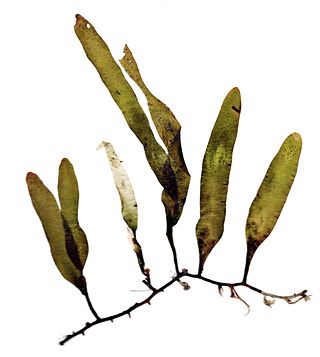
Caulerpa is a genus of seaweeds in the family Caulerpaceae. They are unusual because they consist of only one cell with many nuclei, making them among the biggest single cells in the world.

Halimeda is a genus of green macroalgae. The algal body (thallus) is composed of calcified green segments. Calcium carbonate is deposited in its tissues, making it inedible to most herbivores. However one species, Halimeda tuna, was described as pleasant to eat with oil, vinegar, and salt.
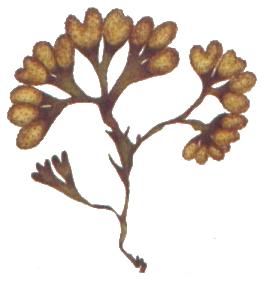
Fucus spiralis is a species of seaweed, a brown alga, living on the littoral shore of the Atlantic coasts of Europe and North America. It has the common names of spiral wrack and flat wrack.

Dictyotales is a large order in the brown algae containing the single family Dictyotaceae. Members of this order generally prefer warmer waters than other brown algae, and are prevalent in tropical and subtropical waters thanks to their many chemical defenses to ward off grazers. They display an isomorphic haplodiploid life cycle and are characterized by vegetative growth through a single apical cell. One genus in this order, Padina, is the only calcareous member of the brown algae.

Bryopsis, often referred to a hair algae, is a genus of marine green algae in the family Bryopsidaceae. Species in the genus are macroscopic, siphonous marine green algae that are made up of units of single tubular filaments. They can form dense tufts up to 40 cm in height. Each cell is made of up an erect thallus that is often branched into pinnules. Approximately 60 species have been identified in this genus since its initial discovery in 1809. The ecological success of Bryopsis has also been attributed to its associations with endophytic bacteria that reside in the cytoplasm of their cells.

Turbinaria is a genus of brown algae (Phaeophyceae) found primarily in tropical marine waters. It generally grows on rocky substrates. In tropical Turbinaria species that are often preferentially consumed by herbivorous fishes and echinoids, there is a relatively low level of phenolics and tannins.

Halimeda tuna is a species of calcareous green seaweed in the order Bryopsidales. It is found on reefs in the Atlantic Ocean, the Indo-Pacific region and the Mediterranean Sea. Halimeda tuna is the type species of the genus Halimeda and the type locality is the Mediterranean Sea. The specific name "tuna" comes from the Taíno language, meaning "cactus" and referring to the resemblance of the thallus to the growth form of an Opuntia cactus.
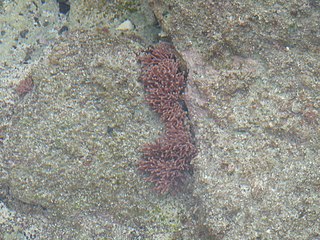
Amphiroa is a genus of thalloid red algae under the family Corallinaceae.
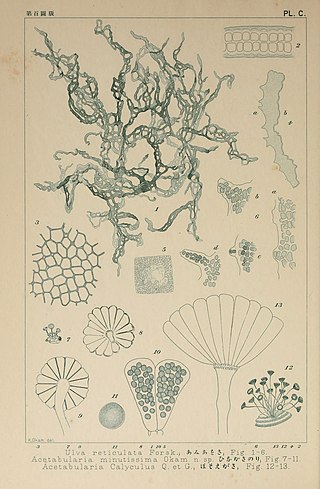
Acetabularia caliculus, the umbrella alga, is a species of green alga found in shallow temperate and tropical seas. It usually grows on pebbles, shells or pieces of rock, and is often found in seagrass meadows, on mudflats and coral reefs, in estuaries and growing on the submerged roots of mangroves. Each individual thallus consists of a single cell with a long stipe and a terminal cup-shaped or flattened disc.

Lobophora is a genus of thalloid brown seaweed of the Phylum Ochrophyta; Class Phaeophyceae.
Lobophora variegata is a species of small thalloid brown alga which grows intertidally or in shallow water in tropical and warm temperate seas. It has three basic forms, being sometimes ruffled, sometimes reclining and sometimes encrusting, and each form is typically found in a different habitat. This seaweed occurs worldwide. It is the type species of the genus Lobophora, the type locality being the Antilles in the West Indies.

Dictyota is a genus of brown seaweed in the family Dictyotaceae. Species are predominantly found in tropical and subtropical seas, and are known to contain numerous chemicals (diterpenes) which have potential medicinal value. As at the end of 2017, some 237 different diterpenes had been identified from across the genus.
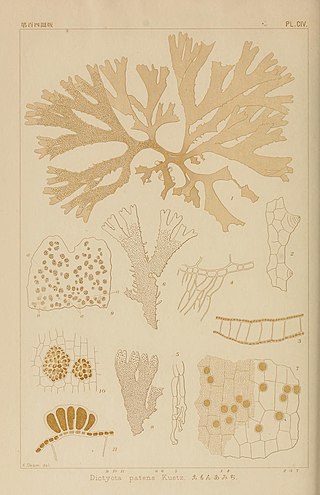
Dictyota bartayresiana, commonly known as a forded sea tumbleweed, is a species of brown alga found in the tropical western Indo-Pacific region and the Gulf of Mexico. It contains chemicals that are being researched for possible use as antimicrobials, as larvicides and as cytotoxins.

Udotea flabellum is a species of photosynthetic macroalgae. It is commonly found in shallow waters around Florida and Belize in sandy areas, sea grass beds, and coral reefs. It is known for its antimicrobial properties and is also being used in cancer treatment studies.

Dictyota dichotoma is a species of Brown algae found in the temperate western and eastern Atlantic Ocean, the Mediterranean Sea, the Black Sea, the Red Sea and the western Indian Ocean.
Dictyota spiralis is a species of brown alga found in the temperate eastern Atlantic Ocean and the Mediterranean Sea.
Dictyota sandvicensis also called limu 'Alani in Hawaiian, is a species of brown seaweed in the family Dictyotaceae endemic to the Hawaiian Islands.











